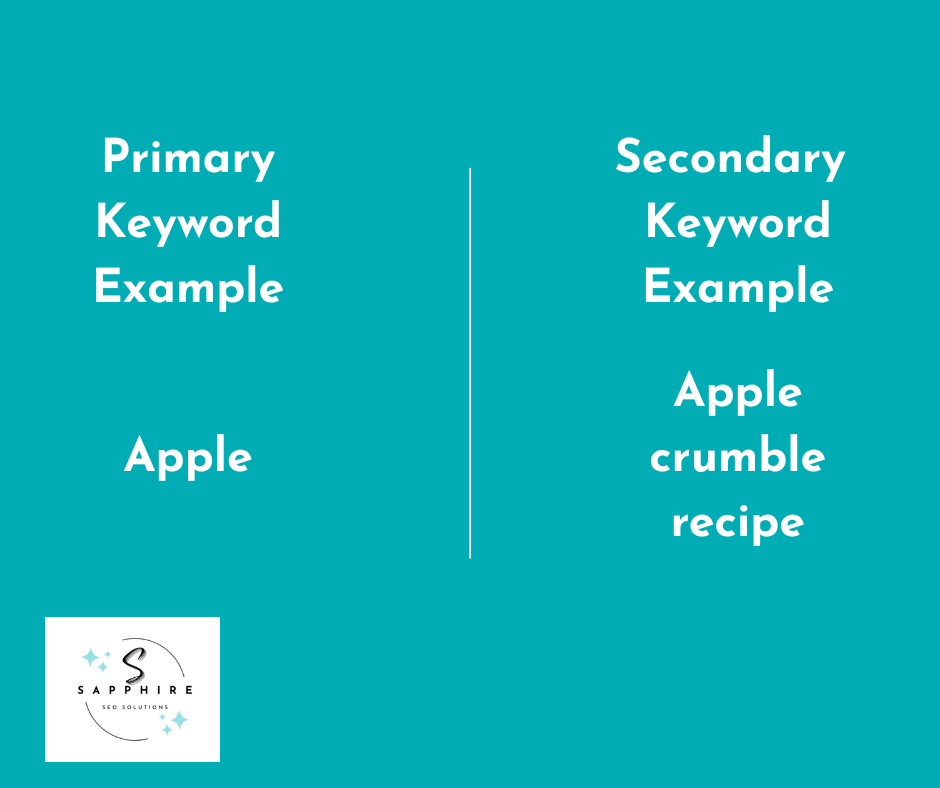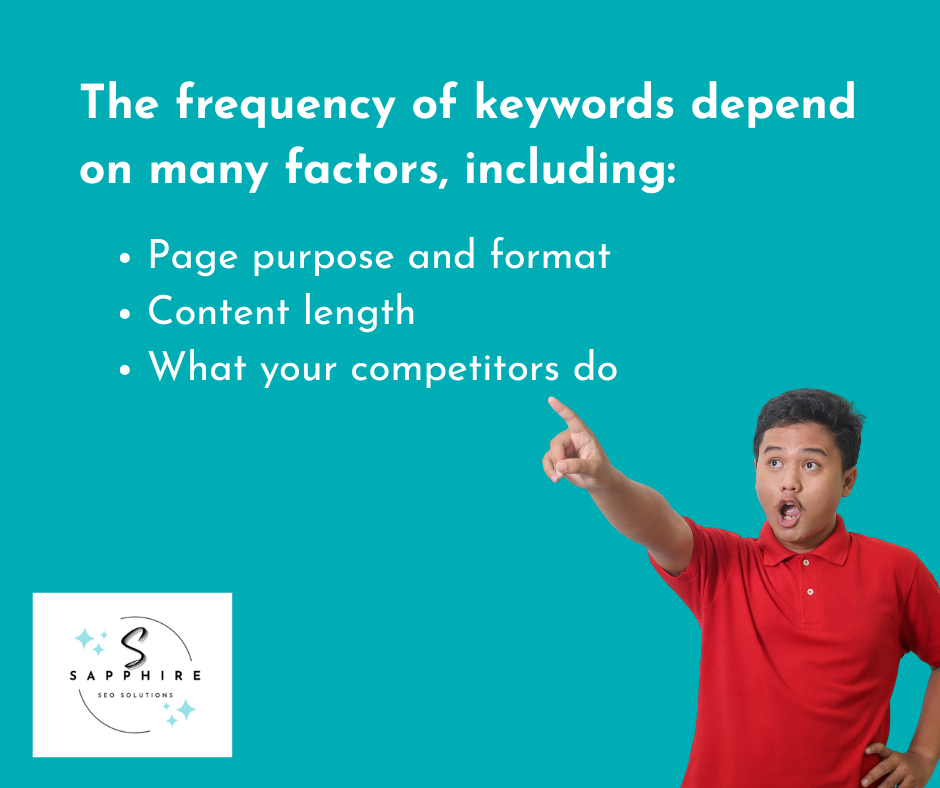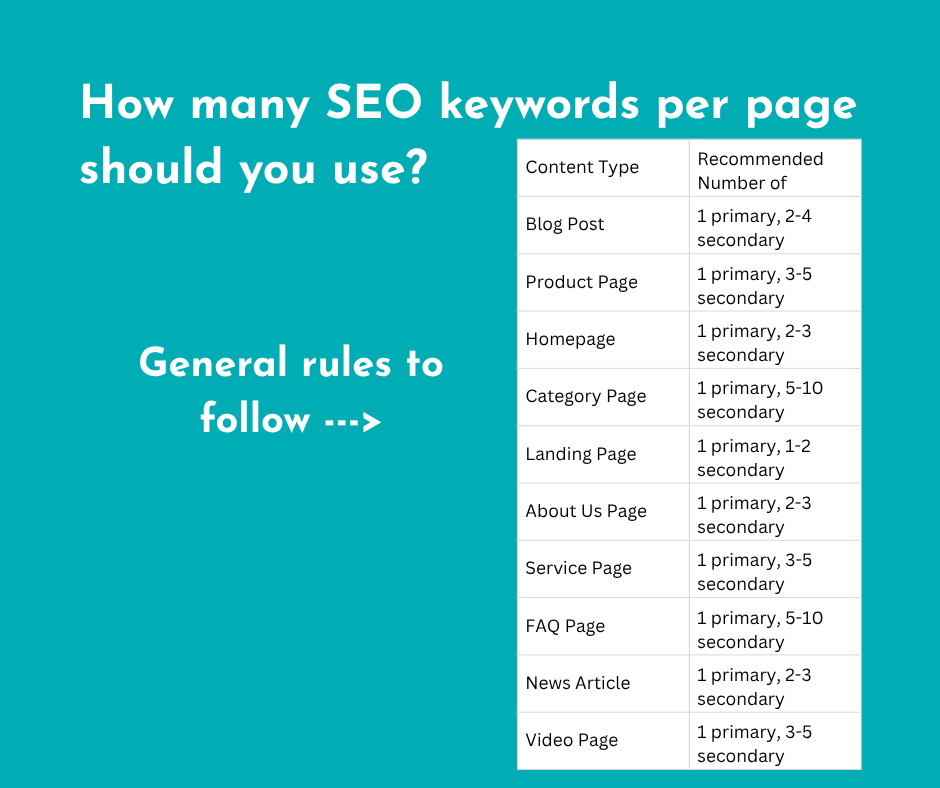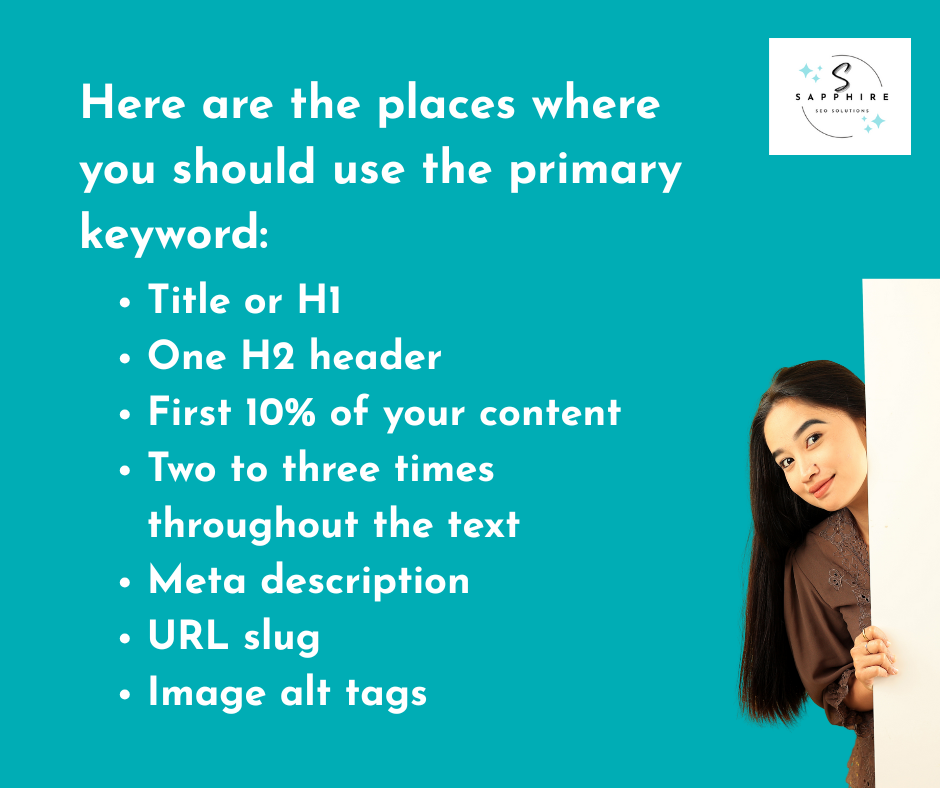How Many SEO Keywords Should I Use? (2025 Guide)
Wondering "how many SEO keywords should I use to rank higher in 2025?" Discover the right balance between primary, secondary, and long-tail keywords to boost your search visibility. Learn proven keyword placement strategies, ideal keyword density, and how to avoid keyword stuffing while keeping your content natural and engaging. Whether you’re optimizing blog posts, product pages, or service pages, this guide from Sapphire SEO Solutions shows you how to choose and use the right keywords to improve rankings, attract organic traffic, and meet user intent.
Key Takeaways
Use one primary keyword and several secondary keywords to optimize each page effectively.
Ideal keyword density ranges from 0.5% to 2% for natural, reader-friendly SEO content. But don’t follow this “rule” blindly and only use it as a guideline.
Focus on search intent and content quality, not just keyword placement, to improve rankings.
Avoid keyword cannibalization by assigning one keyword focus per page and mapping content topics.
Use keyword research tools like Google Keyword Planner or Semrush to find high-value, low-competition keywords.
Is ranking content super important for you? Are you simply writing content to get results? You need to stop, take a step back, and start assessing what you're publishing.
Most business owners are publishing content without knowing the best practices. And even if they know what to do, they're not doing it right. The results? Tons of pages that are not ranking or getting any traction.
If you're reading this, you're probably facing the same problems as many other business owners: poor quality content that's not ranking in search results. Heck, it's not even attracting AI search engines.
Is a lack of keywords the main issue? Are you not using the right keywords? Is the content only about keyword optimization?
At Sapphire SEO Solutions, through our affordable SEO-optimized content writing services, we have been helping to create effective content for small and medium-sized businesses since 2007. Our team of SEO professionals and writers works together, following the latest industry guidelines to ensure that every content, whether it's articles, blogs, landing pages, service pages, or more, ranks and performs well.
While keyword research is super important, it's also crucial to create content that's not only optimized for search engines but also provides value to the readers. Search intent is even more crucial, and we will cover all of these aspects in this comprehensive guide.
Let's get started!
What Are SEO Keywords?
When people search online for something, whether it's a product, service, or information, in search engines, they use certain phrases or search terms. These are commonly referred to as keywords, and they are an important part of SEO content. They help guide users and search engines to your content or website.
Let's look at a quick example so you have clarity about what keywords are.
You're offering guitar tutoring sessions and have a fully optimized website for many different keywords, including "best guitar lessons online." If someone searches for that term on Google, chances are that the search engine shows them your website since you're already ranking for that particular keyword.
What Is the Importance of SEO Keywords?
Why are SEO keywords important? Because they help people find what they're looking for in search engines. How so?
Google has many algorithms in place that scan billions of pages when you search for something. The search engine finds the best matches based on search terms.
If your pages contain relevant keywords and match the context and user intent, Google or other search engines will more likely recommend your page to users.
However, choosing keywords is not so simple. There are certain rules to follow. In fact, you need to pay close attention to the following key factors:
Keyword difficulty: This refers to the difficulty level of a particular keyword. The higher it is, the challenging it will be to start ranking for that term, especially if your site has a low authority score. Competitive keywords have high difficulty and are very competitive, while less competitive keywords are easier to rank for and still bring relevant traffic.
Search volume: This refers to the number of people searching for that particular keyword. A high search volume suggests that many people are searching for that keyword, which means targeting that search term can draw more visitors. That said, these high-traffic keywords often have incredibly high keyword difficulty, making it challenging to start ranking for them.
Keyword relevancy: This is super important because it shows how well a target phrase matches your topic. Search engines prefer pages that match the right user intent, which means using the right keywords is crucial for business owners.
Read our blog on “Keyword Research for Construction Companies” to learn about the basics of finding the right search terms. It also goes into more detail about the different metrics like keyword difficulty and relevancy, among others.
There are three important terms that you need to know when it comes to search engine terms, and they include the following:
Primary keyword: This is your main keyword. It describes what your page is about, addressing the user intent. It could be "running shoes" if you're a shoe store owner with a website. It needs to be short, simple, and straightforward.
Secondary keywords: These search terms are more detailed. Instead of "running shoes," a secondary keyword could be "best running shoes". This keyword can help attract a specific set of visitors.
Long-tail keywords: Long-tail keywords are often overlooked, but they've recently gained a lot of importance. These are specific prayers, such as "women's waterproof trail running shoes size 8." While fewer people may search for this, these are the people who are ready to buy the product.
What's the Difference Between Primary and Secondary Keywords?
Let's discuss the different search terms (primary and secondary keywords) in a bit more detail.
Primary keywords are the main search terms that you target for a certain search intent. It's what you use to optimize your content to attract the right audience, whether they are looking for information or want to purchase a product. They're often repeated multiple times, in high-impact areas, to gain the attention of search engines.
On the other hand, secondary keywords are search terms that are closely related to the primary keyword. Often, they are similar in context and convey additional ideas.
These keywords could be different variations of the primary keyword. If the primary keyword is "marketing", the secondary keyword could be "digital marketing".
Other than these two, there is another type of search term that's referred to as latent semantic indexing (LSI keywords).
These are variations, synonyms, or conceptually related terms, and these semantic keywords help search engines understand the content's context and depth. But please note that they must be used sparingly.
Then there are long-tail keywords. They are detailed phrases or questions. Often having lower search volume than primary keywords, they are relevant to the main topic and divert relevant traffic.
Long-tail keywords are super important. In fact, Backlinko states that 91.8% of all searches on the internet are long-tail keywords. You should use a variety of these search terms across your articles.
According to Search Engine Land, long-tail keywords tend to have lower search volume but higher intent and less competition, making them easier to rank for.
What Are the Benefits of Using SEO Keywords?
Why should you use SEO keywords in your content? Simply put, they provide many different benefits, including the following:
Improve ranking on Google search
Reaching your target audience
Boosting organic traffic to your website
Increasing conversions and achieving SEO success
A key thing to remember is that while keywords are important, it’s crucial that your content follows Google’s E-E-A-T guidelines. Without helpful content, you won’t rank. In fact, Rankability analyzed 1,536 Google search results and found that the top 10 Google results only had a keyword density of 0.04%. This suggests that Google prioritizes factors other than the frequency of keywords.
How Many SEO Keywords Should I Use?
There is no set of rules when it comes to the ideal number of keywords to use for search engine optimization. It all depends on the following factors:
Page purpose and format: Your homepage might need three to five main terms. A blog post can naturally include 15 to 30 queries because they cover detailed topics.
Content length: A 500-word page might include five to seven target phrases, while a 3,000-word guide can incorporate 20 or more keywords. Remember, the longer your content, the more keywords it can naturally accommodate.
What your competitors do: Check pages already ranking high for your target keywords. Notice how many keywords they use for a realistic benchmark.
Surfer SEO is a great tool that you can use to check keyword density and identify the right number for effective SEO. The ideal keyword density is below 3% in most cases, keeping content readable while signaling to search engines what your page is about.
How many SEO keywords per page should you use?
As a rule of thumb, use around one to four SEO keywords per page, relating to the same topic. That's roughly one to two keywords every 100-150 words or a keyword density of 0.5% to 2%, including one primary keyword and other secondary keywords.
However, the number depends on the content type. A product description with a low word count needs more keywords (almost 5-10 per page) to rank. This isn't typical for blog articles, where one to four keywords per page suffice.
Here's a quick glance at how many keywords per page for each content type:
Blog Post - 1 primary, 2-4 secondary
Product Page - 1 primary, 3-5 secondary
Homepage - 1 primary, 2-3 secondary
Category Page - 1 primary, 5-10 secondary
Landing Page - 1 primary, 1-2 secondary
About Us Page - 1 primary, 2-3 secondary
Service Page - 1 primary, 3-5 secondary
FAQ Page - 1 primary, 5-10 secondary
News Article - 1 primary, 2-3 secondary
Video Page - 1 primary, 3-5 secondary
Do not follow the 0.5% to 2% keyword density rule blindly. This is because some texts, like scientific texts or research papers, have a higher keyword density. This range should be used as a general guideline.
How Should I Use SEO Keywords? (Best Practices of Using SEO Keywords)
Keyword placement makes a difference for SEO. Here's where to put your target terms:
Title or H1: Include one primary keyword, preferably near the start. It tells search engines and visitors about your page's content.
One H2 header: Use your main ranking phrase or a close variation in subheadings.
First 10% of your content: Include your keyword in the first paragraph so Google understands what your page is about.
Two to three times throughout the text: Insert primary and secondary keywords naturally into your sentences. Don't keyword stuff. Avoid too many keywords that make the content feel unnatural. It's a black hat tactic that can harm your site's SEO.
Meta description: Adding one keyword here can grab attention in search results and encourage clicks.
URL slug: Use clear URLs like "website.com/your-keyword" instead of "website.com/page54392."
Image alt tags: Add relevant keywords to image alt text, especially for online stores, to appear in image search results.
Keyword Cannibalization
This happens when multiple pages on your site try to rank for the same keywords, dividing your authority and hindering performance.
Here's how to fix it:
Create a content map: Identify which search term each single page should target to avoid overlap.
Combine similar content: Merge multiple pages covering the same topic into one in-depth article.
Set up redirects: After combining content, redirect old URLs to your new page to pass ranking strength.
Use internal linking wisely: Link from less important pages to your main page on a topic so Google understands which page is most valuable.
Use Only One Primary Keyword Per Article
Every primary keyword conveys one distinct idea. Use just one primary keyword in an entire article to stick to that idea throughout.
Use it multiple times. Around two to three times every 500 words for SEO is enough. Use additional secondary keywords or a few supporting keywords to cover supporting topics and maintain the "one to four keywords per page" range.
Why NOT to Use Multiple Primary Keywords
Using multiple keywords as primary keywords in a single article is neither necessary nor practical from an SEO or reader's perspective.
When people search for a query, they're looking for that particular information. As an SEO professional, your job is to make it easy for readers to find that information. More than one keyword as primary will frustrate them and drive them away.
From an SEO perspective, it's simply not necessary. Closely related topics are covered by secondary keywords. Unrelated topics don't belong in the article.
Optimizing an article for one primary keyword means it will automatically rank for related keywords as well. One article optimized for a single primary keyword can rank for thousands of related terms.
So one primary keyword is enough. Secondary keywords cover remaining topics.
How to Find Primary and Secondary Keywords
You know how many SEO keywords per page you need. But to use them and get the best SEO results, you need to find the right keywords through keyword research.
Say you run an online fashion business and want to write about "winter fashion." You need to know what exactly people search for when looking for winter fashion and what related information they want.
Use a Keyword Research Tool
Using keyword research tools such as Google Keyword Planner, SE Ranking, and Semrush is the easiest way to find primary and secondary keywords.
Enter your "seed keyword" (the broad topic idea) in the tool using the search bar or search function, click "Identify Keywords," and get a complete overview with search volume and difficulty. You may also see lists of keywords under tabs like "Same terms," "Related," "Also rank for," and "Competitor terms", depending on the tool you use.
A good primary keyword has high search volume. However, high search volume can mean high competition.
Our advice: Choose a specific keyword with high search volume and low difficulty for a better chance at ranking. Fewer keywords with the right balance often perform better than targeting many keywords poorly.
For secondary keywords, check the "Related," "Also rank for," and "Competitor terms" tabs. These keyword variations are closely related to the primary one. Choose terms relevant to your core topic. Look for different keywords that support your main topic without competing with it.
What are the best keyword research tools?
Here are some of the best keyword research tools you can use:
Free tools:
Google Keyword Planner: Provides search volume ranges and competition levels directly from Google's data.
Google Search Console: Shows what terms you're already ranking for and their click-through rates.
AnswerThePublic: Visualizes questions people ask about your topic.
Paid tools:
Semrush: Shows keywords, what competitors rank for, and content gaps. Includes backlink profile analytics. These SEO tools are comprehensive for all your optimization needs.
Ahrefs: Great for in-depth competitor analysis, displaying ranking pages, word count, backlinks, and more.
The Reasons Your Page Still Ranks Low - (Why Is My Page Ranking Low Even Though I've Optimized It with SEO Keywords?)
Even if you've incorporated keywords naturally, your rankings and traffic might not improve. Many SEO professionals say that the biggest misconception about search engine optimization is the thought that " SEO is about keywords". They're right.
There are many factors that are as important as keywords, if not more, and they include the following:
The right intent: Your content must match search intent. Evaluate top results for your target terms. If your format doesn't align with the top pages on Google and other search engines, they might not rank it highly.
Content quality: Thin or surface-level content won't rank well. Successful copy aligns with Google's E-E-A-T guidelines (Experience, Expertise, Authoritativeness, and Trustworthiness). Don’t forget to read our comprehensive guide on “How SEO and Content Writing Services Work in 2025!” to learn how such services can boost your site’s credibility, authority, and eventually organic traffic.
On-page optimization: Review your headings, image alt text, internal links, meta tags, and schema markup to ensure everything is SEO-optimized. Check out our guide on on-page SEO for more information.
Tech errors: Slow load times, mobile-friendliness issues, crawl errors, and duplicate content harm rankings. Run technical audits with tools like Google Search Console. Head over to our technical SEO page for detailed information.
Competition level: Some terms are more competitive. Newer or smaller sites struggle with high-volume keywords that big sites dominate. Target less competitive keywords first and focus on quality content and natural backlinks. Avoid keyword stuffing as this will harm rather than help your rankings, even if a keyword appears frequently.
Go Beyond Keywords If You Want to Start Ranking. Sapphire SEO Solutions Can Help!
Keywords are not the only SEO element that business owners should focus on. With the future of search being generative engine optimization, the use of keywords is pushed even further back. It's not all about search intent and making content easy for readers and AI search engines to go through and understand.
This is what we at Sapphire SEO Solutions have perfected. Even in recent months, when business owners are seeing a drop in rankings or organic traffic, our SEO strategist delivered a 158% increase in organic traffic for a US-based candy seller. We plan ahead, ensure consistent quality of work, and monitor important metrics so that we can adjust our strategy on time.
Our SEO experts work with clients, creating the perfect content calendar that targets the right keywords and search intent, conducting technical SEO, including adding the right schemas, and optimizing the content for structure.
Want to start ranking? Fill out the online contact us form to schedule a free consultation with an experienced SEO professional today.
Need SEO-optimized content or AI SEO content? Check out the different content writing tiers we offer, and place an online order to get started!
Frequently Asked Questions - How Many Keywords Should I Use
Are too many keywords bad for SEO?
If you use your primary keyword so many times that your content feels strange to read, it can be bad for SEO. Your content should read well and include your keyword phrase naturally. There's no limit to keyword variations and secondary terms as long as they fit naturally into your content. Remember, keyword stuffing is a black hat SEO tactic that search engines hate. You might even get penalized.
What are the 4 types of keywords?
The most common keywords are commercial, transactional, informational, and navigational. Understanding keyword types helps you create the right content to meet user intent, share information your audience seeks, build trust, and encourage sales.
Should I always target a specific keyword?
You should usually target a specific keyword for SEO, but there are exceptions. For example, it might not make sense to target only one keyword on your homepage. Instead, incorporate various keywords as you see fit. While most blog articles should target a specific keyword so your audience can find the content, you might write some for creativity, thought leadership, or to announce special offers or updates. In this case, share this content on other platforms like Pinterest, social media, or your email list.
Do I need to track every keyword I include on a page?
Tracking every keyword you include is unnecessary and can be distracting. Focus on monitoring the primary keyword (in this case, “How many SEO keywords should I use”) plus one or two key secondary phrases that are important to your content strategy. This allows you to see meaningful ranking shifts and organic traffic changes without getting lost in a long list of low-impact terms.
If I write multiple pages on my site covering similar topics, can I use the same primary keyword?
Using the same primary keyword on multiple pages risks keyword cannibalization, where search engines struggle to decide which page should rank for that term. Instead, assign each page a unique primary keyword and use secondary keywords for related phrases. That way, each page targets a distinct idea, and you avoid competing against your own content.
How long should my content be to effectively use one primary keyword and supporting keywords?
There’s no one-size-fits-all word count, but longer, well-structured content gives more opportunity to naturally include your primary and secondary keywords while covering related topics. For a blog post, you might aim for 1,000+ words, allowing you to feature your primary keyword, a handful of secondary ones, and a few long-tail variations without forcing them.










